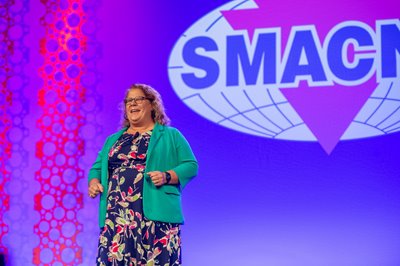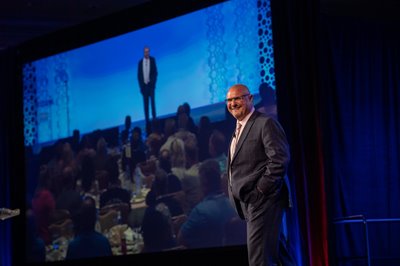
Al LaBella, SMACNA's 2021-2022 president
The Sheet Metal and Air Conditioning Contractors’ National Association welcomed 825 attendees Oct. 24 – Oct 27 to Maui, Hawaii for its first in-person annual convention since the COVID-19 pandemic struck in early 2020.
“But we all pulled through the past couple of years and learned about ourselves, the industry and our processes,” added Vince Sandusky, SMACNA's CEO. “I was impressed by the level of common sense and flexibility our contractors and labor partners showed to keep work moving and our workforce safe in the process.” “The pandemic changed who we are and how we do business,” emphasized SMACNA’s immediate past president Angie Simon.
The industry showed tremendous resilience, adapting quickly to the changes necessary as the pandemic deepened. “One positive we experienced from the pandemic was the huge kick in the pants we got when it came to technology,” said Angie Simon, SMACNA's immediate past president. “From virtual platforms to embracing prefabrication to having fewer people on job sites to working in more controlled shops to 3-D cameras helping us work at job sites without being there – I’m really impressed with how we found ways to get the jobs done and deal with the shutdown, supply chain issues, workforce issues, the price of steel, and now vaccine mandates. Regardless of the issue, we have adapted and thrived and that is inspiring.
In addition to a golf outing, a trade show and lots of opportunities for networking and interaction, here is a look at some of the insights gained during the annual convention.
Embrace Diversity, Equity and Inclusion
Steve Pemberton kicked off the general session on Oct. 25, with a look into diversity, equity and inclusion, giving attendees some ideas to ponder about the challenges and opportunities the industry faces and how overcoming them can enable future growth.
“Diversity, equity and inclusion is going to be necessary and essential to the growth of our businesses,” Pemberton pointed out. “We must find the connected story in our organizations.”
How to Minimize Risks in Today’s More Connected World
“I have yet to walk into a corporation or an organization – and I work with Fortune 100 companies – that is fully defended against cyber-attacks,” explained Nick Espinosa, an expert in cybersecurity and network infrastructure and founder of Security Fanatics.
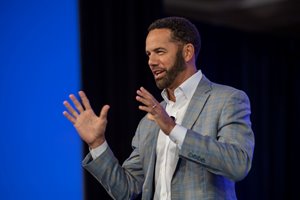
Steve Pemberton, speaker on DE&I
He kicked off his SMACNA General Session by hacking into phones and computers in the room through a fake conference Wi-Fi he set up to show attendees that a successful cyber-attack happens every 39 seconds.
It takes on average 192 days for a company to even realize they’ve been hacked, Espinosa added. He offered attendees tips for how they can better defend their businesses against these threats:
- Never use free or public Wi-Fi. Bring your own hotspot.
- If you must use public Wi-Fi, firewall your devices or use a virtual private network (VPN). Espinosa says lazy hackers won’t take the extra time to try and get through these blocks.
- Use multifactor verification, such as text or voice verifications or a temporary code that changes regularly.
- Have good backups.
- Change up your passwords; they should not be the same for your social media and your bank or other more important log-ins.
- Companies need both IT and cybersecurity staffs. Those teams should educate all users at the company on best practices and how to avoid threats.
- Change up your cybersecurity plan every 18 months to two years, so they don’t become outdated
How to Become a Leader That Inspires Employees
When Marine sniper Jake Wood came back to the U.S. after two grueling tours in Iraq and Afghanistan, he watched his unit lose more men to suicide than to enemy hands overseas. Wood talked to attendees about how they can build a more dedicated following at their companies.
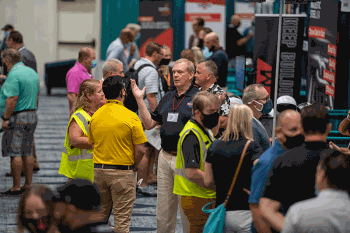
Rick Hermanson promoting the Heavy Metal Experience at the Product Show
Becoming a better leader starts by looking at the largest group of people in your organization. “Many of your employees are a mindless flock that go about their days,” Wood explained. “They aren’t bad or untalented. They are just uninspired by the leaders they are following.”
The big question is: “How do we unlock the potential within this group?” Wood asked.
He gave the leaders in the room some tips on how to better structure their organizations to tap into this talent.
- Establish a vision. “Every organization is a story – it has a beginning, middle and end with plot twists and heroes and villains,” Wood explained. “How can you craft your final chapter that shows what you’re trying to do?
- Write your final chapter first.” Your vision then serves as a magnet for the talent you want to recruit and retain.
- Treat people in your organization like heroes. “If you think of your organization as a story, “and you treat people like unnamed characters on page 56 of your story, that’s how they will act,” Wood pointed out.
- Create a culture that counts. Wood defines culture as the intangible sum of everything you do and all you believe at your company. “When you build an ethical leadership organization, the vision, people, policies, processes, pay and practices must all match,” Wood said. “If you have a policy that contradicts your values, you immediately make them null and void.” And this can destroy your company culture.
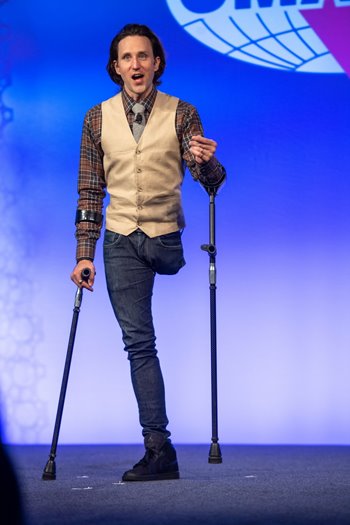
Josh Sundquist, a keynote speaker
Develop a Motto to Keep You Going Through Life’s Challenges
Josh Sundquist is a Paralympian and bestselling author of “Don’t Just Fall: How I Grew Up, Conquered Illness, and Made It Down the Mountain.” At age 9, Josh Sundquist was diagnosed with a rare form of bone cancer. At age 10 his leg was amputated, gaining him a life free of cancer.
Sundquist decided nothing was going to stop him from his dream of ski racing. At 16, he began training. It took him six years, but in 2006 he was named to the U.S. Paralympic Ski Team.
Falling down and getting back up multiple times was how Sundquist survived, cycling through stages of disappointment and commitment. But he kept crossing the finish line. “Sometimes falling is a setback, but we also learn something. When we get back up, we have a slightly wiser outlook. When we cross that finish line, we feel accomplishment.”
The motto that constantly guides Sundquist, and that he offered to conference attendees: “One more thing, one more time.”
Further Strengthen the SMACNA-SMART Partnership
With any continued partnership, the important thing is growth, explained Joseph Sellers Jr., general president of SMART, the international association of sheet metal, air, rail, and transportation workers.
Sellers spoke to the SMACNA conference group about how strong labor relationships are crucial, as is building on that partnership trust.
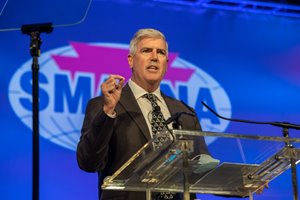
Joseph Sellers Jr., general president of SMART
A continued area of focus will be diversity, equity and inclusion, Sellers said, adding that while these goals aren’t new, the industry could be doing better.
“One of our goals in 2019 was to double the women in our organizations,” he said, “but two years later, words proved not enough. We need an action plan.
“We also need to stop discrimination, harassment and bullying in our organizations,” Sellers added. “Doing this today will make us better tomorrow.”
Additionally, the industry continues to evolve, and as air quality becomes more important, “we have the expertise to offer,” Sellers pointed out.
Sellers’ goal is to continue to identify and address areas of concern. “Using our collective knowledge, we should be able to take our industry to another level.”
Welcome a New SMACNA President
During the convention, attendees got the chance to welcome SMACNA's new President Al LaBella.
LaBella, owner and president of Blue Diamond Air Systems, Medford, New York, shared some of his life lessons with the group. He told the story of a football coach he had growing up. “The first thing he would say to us every day was, ‘Did you get better today?’” he says. “At the time, we thought he was talking about football, but he was actually talking about life.
“My advice to this group is to ask yourself on a regular basis, ‘Did I get better today? Did I become a better leader? A more effective communicator? A better listener?’”
Introducing the 2021-2022 Board
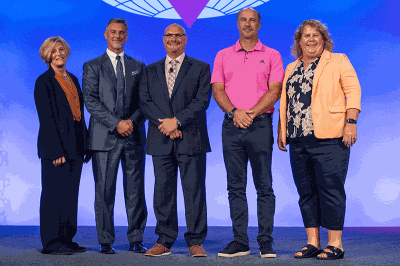
President: Al LaBella, owner and president of Blue Diamond Air Systems, Medford, New York
President-Elect: Tony Kocurek, owner of Energy Balance & Integration, LLC, Albuquerque, New Mexico
Secretary-Treasurer: Carol Duncan, CEO and owner of General Sheet Metal, Clackamas, Oregon
Vice President: Tom Martin, president, T.H. Martin, Cleveland, Ohio
Immediate Past President: Angie Simon, CEO, Western Allied Mechanical, Menlo Park, California
New Directors:
Todd Byxbe, Miller Engineering Co., Rockford, Illinois
Matt Hildreth, The Waldinger Corp., Wichita, Kansas
Mitch Golay, Corn States Metal Fabricators, West Des Moines, Iowa
Roy Jensen, MechOne, Colorado Springs, Colorado
2021 Award Winners
Contractor of the Year: Randy Novak, president, Novak Heating & Air, Cedar Rapids, Iowa
Legislative Contractor of the Year: Tom Martin, president, T.H. Martin, Cleveland, Ohio
Chapter Executive of the Year: Jon Sindyla, CEO, SMACNA-Cleveland, North Royalton, Ohio
Chapter Executive Legislative Advocate of the Year: Ginger Slaick, executive vice president, Georgia-SMACNA, Hoschton, Georgia
Delta Update: How HVAC Systems Impact COVID-19 Transmission
In light of the new Delta variant of COVID-19, Steve Taylor, principal of Taylor Engineering, and Eli Howard, executive director of technical services and research for SMACNA, highlighted new research on how HVAC systems impact the probability of COVID-19 transmission for SMACNA conference attendees.
The biggest change is what we’ve learned about how COVID is transmitted. “Last year, when discussing this topic, this was still a mystery. But it’s clearer now,” Howard said.
“The CDC originally assumed the big droplets were the main cause, but now they may not be a part of the whole picture,” he added.
Large particles (100 microns or bigger) are where the 6-foot social distancing rule came from. Larger particles generally don’t go further unless they are forced to travel longer distances, such as through a sneeze.
Then there are medium-sized droplets that start between 5 and 10 microns and go up to 100 microns. Particles larger than 15 to 20 microns settle very quickly, while particles less than 10, 7 or even 5 microns are light enough that they can float around a bit. Aerosols and those less than 5 microns are light enough to behave like a gas. “And that’s important to note because these are the particles that can actually leave the room and be affected by ventilation,” Howard said. “Ventilation does little for the larger droplets.”
A challenge for the industry is whether or not we can filter virus particles traveling from one floor to another. So far, there isn’t a lot of proof that the virus-laden particles travel from one floor to the other. The reason? “Aerosols are small to begin with, so they don’t carry a lot of virus,” Howard explained, “and their viability gets less and less over time.”
This could potentially have huge implications for our industry because if this isn’t happening, then we’re not going to have any impact on transmission. Bringing in more outside air, which has been recommended, or having better filters may do nothing to impact transmission. “How much ventilation do I need to dilute the impact of aerosols? No one knows,” Howard said. “It’s very complicated.”
With masks, this 62.1 rate appears to be sufficient. “Using LEED 62.1 rate plus 30 percent outdoor air helps a bit,” Howard said. “For those vaccinated, the 62.1 rate appears to be well more than sufficient.”
While improving indoor air quality through ventilation and filtration can help remove and dilute virus-laden particles from indoor air, ventilation and filtration are not sufficient on their own to control the risk of transmission, and particularly from close contact exposures.
Howard said the best ways to improve air quality (in order of effectiveness, cost and energy impact) are:
- Source control – vaccinate, test/quarantine, masks, distance, etc.
- Source removal – masks, filtration
- Dilution – ventilation
A Politics, Tax & Construction Update
Stan Kolbe, executive director of legislative and political affairs at SMACNA, and Ron Eagar, COO, Grassi & Co., gave SMACNA annual conference attendees insight on various federal updates that could impact construction businesses.

A moment of lively conversation during one of the SMACNA conference breakfasts.
He started by reviewing PPP loans. The SBA approved more than 11.5 million PPP loans. Of the $953 billion available, approximately $800 billion in loans were made.
Borrowers are now in the forgiveness phase of the program. Companies can apply for forgiveness any time up until the maturity date of the loan.
Eagar also mentioned Employee Retention Credits (ERCs) are refundable credits that businesses can claim on employees’ qualified wages, including employer paid health insurance costs. “Even if a business received a PPP, it could claim ERCs as long as the same wages and health insurance costs are not used for PPP forgiveness purposes and ERC calculations,” Eagar said.
Eager predicted income tax rates will increase. “One of the great tax axioms has always been to defer income,” he said “But with the impending individual income tax rate increases, this thinking has changed 180 degrees. Now you may want to accelerate income into 2021.”
Consider doing the following for year-end tax planning:
- Convert your traditional IRAs to Roth IRAs to shelter future growth from income tax. You’ll also benefit from more flexibility in retirement since Roth IRAs are not subject to retirement plan distribution rules. These are also great assets to pass to your heirs.
- If you’re working, change 401(k) contributions to Rot 401(k) contributions for the same reasons as above. • If your business is a cash-based business, accelerate cash receipts in 2021 and delay paying vendors until 2022.
- Sell appreciated marketable-equity securities, pay tax on the gain at lower rates and reinvest in the same stock at a higher basis.
- Maximize contributions to your HSA. HSAs are triple tax-advantaged accounts, which means contributions are tax-deductible, the money grows tax-free and withdrawals are tax-free for qualified medical expenses.
